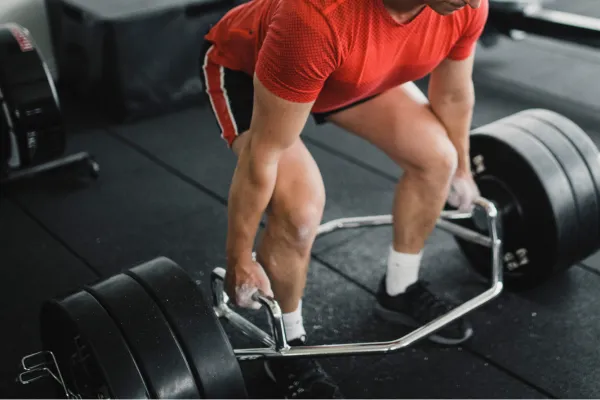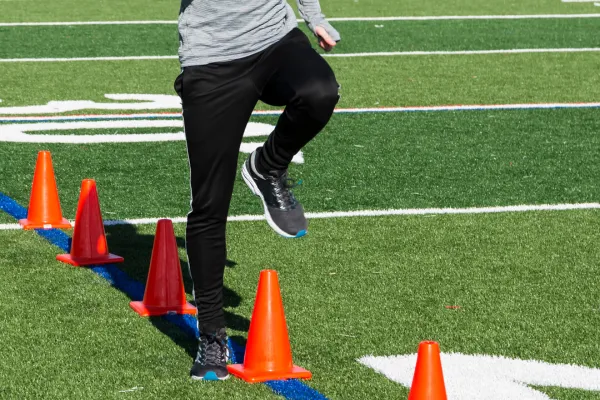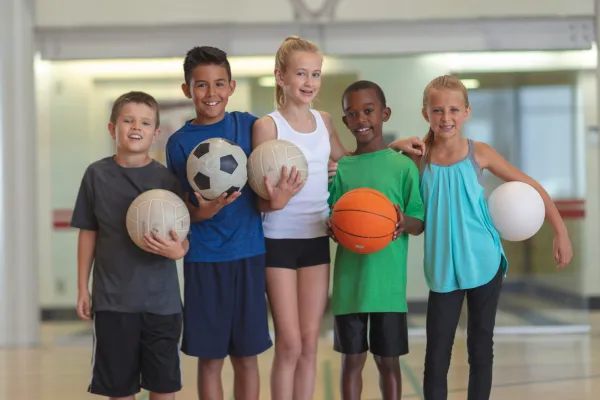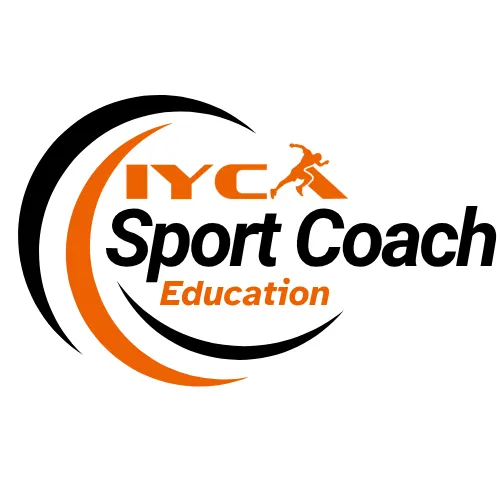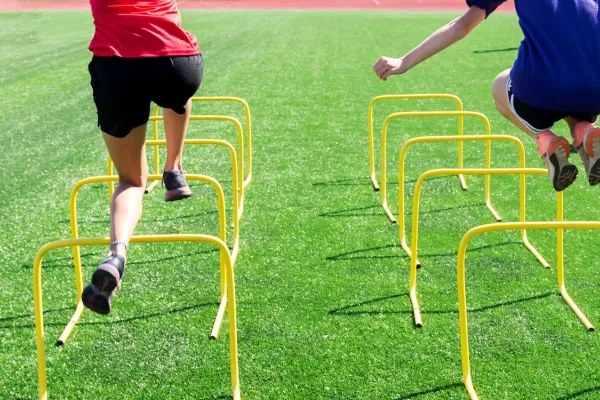
Why Every Great Coach Assesses Their Athletes- Beyond the Scoreboard & Stats
As a coach, you’re constantly evaluating, whether it’s watching how athletes perform in a drill, tracking game-day stats, or observing who shows up ready to work. But the best coaches take it a step further: they assess intentionally and systematically.
They understand that assessment is more than numbers; it’s insight, and when done consistently, it serves as a powerful indicator for progress or regression. It's about seeing the whole athlete, identifying their current state, and helping them reach their full potential.
When done well, assessments in athleticism, wellness, and behavior give us the data we really need– not just to make better decisions as coaches, but to teach athletes how to take ownership of their development.
Let’s break down how and what to assess, depending on the age and stage of your athletes–and why it matters more than ever in the middle school and high school years.
1. Why Assessing Athleticism Matters
If you coach sports, you coach movement. And movement skill– agility, coordination, balance, strength, speed, power– should be assessed regularly. Not to rank or shame athletes, but to track growth, tailor training, and prevent injury.
For middle school athletes, the purpose of assessment is to establish baselines, identify movement imbalances, and begin introducing training awareness in a way that’s age-appropriate and non-intimidating. At this stage, assessments are less about performance outcomes and more about observation, growth, and education.
We recommend the Big 5 Assessments, which you can learn more about in our Youth Athletic Assessment Specialist Certification

You can also implement simple measurable assessments like:
Vertical jump
Broad jump
5-10-5 Drill
Push-up Holds
Single-leg balance (eyes closed)
Plank holds
Basic movement screens (e.g., squat and lunge form)
A cadence of two to three assessments per year is ideal. This frequency allows for noticeable progress without overwhelming young athletes. The key is to keep the process light, engaging, and focused on effort and improvement, not comparison or ranking.
Middle schoolers are in wildly different stages of growth–what you’re testing isn’t necessarily performance, but readiness, patterns, and potential.
For high school athletes, assessments serve a more refined and targeted purpose. They’re used to track performance over time, support the specific physical demands of each sport, optimize training programs, and proactively reduce the risk of injury.
As athletes become more physically developed and sport-focused, assessments should reflect a higher level of precision and intent. Useful tools at this level include:
10- or 20-yard sprints
Broad jump
Medicine ball throws
Balance
Repeated sprint ability tests
Overhead squats
Lunges
Push-up holds/Timed push-ups
These assessments are most effective when conducted at key checkpoints throughout the year– typically in the pre-season, mid-season, and post-season – to align with training blocks and performance goals.
At this stage, assessment isn’t just about collecting data. It becomes a strategic training tool that helps reinforce effort, identify gaps in development, and provide athletes with clear, measurable indicators of progress. It turns training into something they can see, feel, and believe in.
2. How to Choose the Right Assessments
Ask yourself:
What are the movement qualities most important to my sport?
What age/stage are my athletes in physically and emotionally?
Do I have the time, tools, and training to administer these assessments properly?
What am I going to do with the results?
Keep it simple and actionable. It’s better to do three assessments well and track them over time than to do ten inconsistently. Always ask: "What story does this data tell me about this athlete?"
3. Don't Forget the Invisible Game: Wellness & Habits
Not everything that matters shows up in a sprint time or jump height. In fact, some of the most critical factors influencing performance – like nutrition habits, hydration, sleep quality, and mental agility – are often the most overlooked and under-assessed. Yet these are the very foundations that either support or sabotage an athlete’s ability to perform, recover, and stay consistent.
The truth is, if you’re not assessing where your athletes stand in these areas, you’re at risk of overtraining them and under-developing them. Performance dips, burnout rises, and you’re left wondering why your athletes aren't progressing, despite solid programming.
One of the biggest questions I get from coaches is: "How do I assess this stuff?" The good news is, it doesn’t have to be complicated. A simple rating system can go a long way. When athletes are asked to reflect and rate themselves on key wellness habits, something powerful happens: they begin to see those areas as important. They become more intentional.
In essence, what we assess and talk about, athletes will start to value more and more, and what we celebrate, we’re more likely to duplicate.
When assessing lifestyle habits and mental attitudes, it’s important to move beyond vague questions like “How’s your sleep?” Instead, give your athletes crystal-clear targets and frameworks.
For example (1-Never, 5-Always):
“Rate yourself from 1–5 on: I get an average of 8-9 hours of sleep at night”
“Rate yourself from 1–5 on: I drink eight 8oz cups of water per day”
“Rate yourself from 1–5 on: I eat a meal including protein, carbs, and fruits & veggies 3x per day”
“Rate yourself from 1-5: I feel strong and athletic”
“Rate yourself from 1–5 on: I can stay focused and bounce back quickly after mistakes”
“Rate yourself from 1-5 on: I feel connected to my team and coach, I belong.”
“Rate yourself from 1-5 on: I am confident in my abilities as an athlete.”
These are just a few examples of many. You can easily implement by creating a Google Form and sharing the link with your athlete/team.
This self-assessment approach creates awareness without judgment. It opens the door to better conversations, builds accountability, and allows coaches to spot trends that may affect training outcomes. Over time, it shifts the culture. Athletes begin to understand that performance isn’t just built in the gym or on the field—it’s built in their daily habits, their recovery, their mindset, and their routines.
And that’s the real win.
The goal is not perfection, but awareness. When athletes see that these things matter to you, they start to matter more to them. Since this is often the case, you want to be mindful of the things you assess and how you reinforce them. If you choose to assess certain areas, but you don’t reinforce the principles, athletes will see and feel the incongruence.
4. Every Good Coach Keeps Stats—Beyond the Scoreboard
Too often, coaches focus solely on game-day stats– points, wins and losses, goals, turnovers. While those numbers matter, they only tell part of the story. The most impactful coaches go deeper. They gather data that reflects the full scope of an athlete’s development, tracking things like training consistency, practice attendance and effort, physical progress over time, recovery and wellness patterns, and even leadership moments or behavioral shifts.
Why does this matter?
Because progress doesn’t always show up on the scoreboard. Sometimes, it’s found in increased resilience, smarter decision-making, fewer injuries, or stronger team culture. When you track what really matters, you create a fuller picture, one that allows you to coach more intentionally, adjust more precisely, and communicate more effectively with both athletes and parents.
This kind of information becomes your coaching compass, helping you guide athletes toward sustainable growth, not just short-term results.
5. Assessments Build Buy-In
When assessments are done with care, not as judgment, but as a tool for information, they become a powerful part of the development process.
They help validate the effort an athlete puts into training and growth, reinforcing that progress is being made, even when it’s not immediately visible.
They encourage athletes to take ownership of their improvement by showing them where they stand and what they can work toward.
They open up important conversations around areas like sleep, recovery, and nutrition, topics that often go unspoken but significantly impact performance.
Most importantly, assessments give both coaches and athletes a shared language for measuring and discussing progress.
All of this is especially valuable in the middle and high school years, when young athletes are forming habits, identities, and beliefs about their potential. With intentional assessment, we teach them that their body, brain, and behaviors are all interconnected, and that every part of who they are plays a role in how they show up in sport and in life.
Final Thought
Assessments aren’t just about measuring performance. They’re about elevating awareness, prioritizing what matters, and coaching the whole athlete. Whether you’re coaching middle schoolers still figuring out their bodies or high schoolers striving for the next level, don’t let your coaching stop at the scoreboard.
Keep track. Pay attention. Share the data. And use it to create athletes who are not just good at the game–but built to thrive beyond it.
Ready to Lead with Confidence, Not Guesswork?

The Youth Athletic Assessment Specialist (YAAS) certification was built specifically for coaches like you—working with growing athletes who are still developing physically, mentally, and emotionally. YAAS equips you with age-appropriate assessment tools, teaches you how to interpret what you see, and gives you a proven system to track progress over time. It’s simple, practical, and designed for real-world use in schools, gyms, and team settings.
Learn how to assess speed, agility, strength, balance, and movement quality
Use assessments to improve training—not just to collect numbers
Build athlete confidence by highlighting growth and effort
Start building a stronger foundation for your middle school athletes.
Explore the YAAS Certification: https://iyca.org/athletic-assessment
At the IYCA, we believe great coaches are made—not just born. That’s why we provide practical, age-appropriate, and athlete-centered education designed to support middle school and high school coaches in developing athletes for life—not just the next game.
Whether you're building foundational movement skills in younger athletes or preparing high schoolers for higher-level performance, the IYCA is here to help you lead with clarity, consistency, and care.
Explore our resources and workshops: iyca.org
Need help implementing a Coach Development System for your school or organization?
Schedule a free consultation, and we’ll help you build a training model that meets your coaches and athletes where they are.
Email:[email protected]
Because every athlete deserves a coach who is educated, empowered, and equipped.
Watch the Deep Dive:
Raise the standard. Get IYCA certified today.
Coach Julie Hatfield-Still
About the Author:
Julie is an Author, CEO and Coach. She is the Brand Executive at the IYCA and the President & Founder of the Non-Profit Beyond The Game Alliance, which offers a full suite of workshops and support for teams and individual athletes. In addition to her work as a business consultant and coach of coaches, leaders, and entrepreneurs.
Julie is a Speed Development Specialist and Inner-Game Coach at the college, high school and youth levels.
Visit Julie’s Author Page



